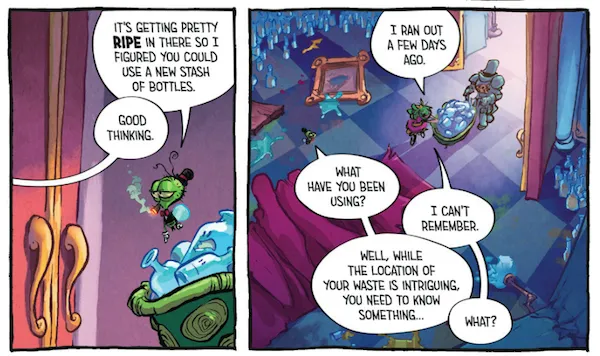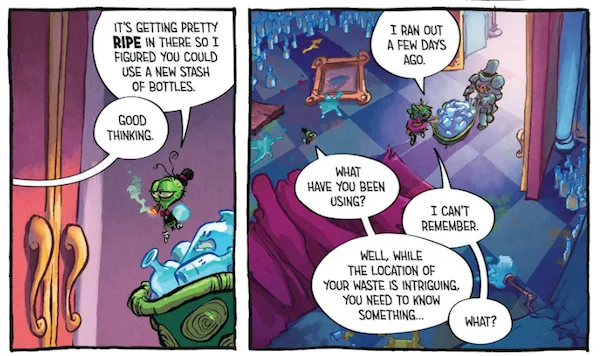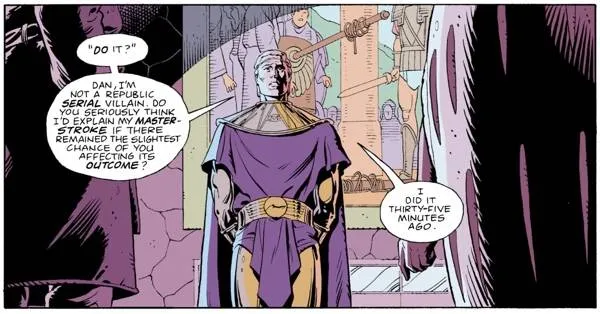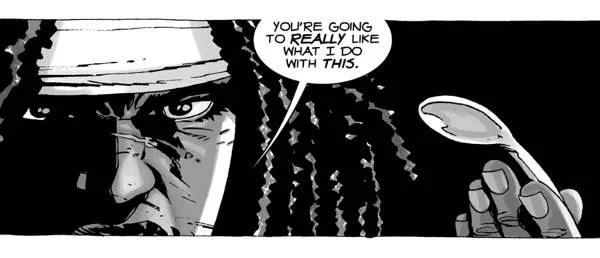
8 Comic Scenes That Still Haunt Us
This content contains affiliate links. When you buy through these links, we may earn an affiliate commission.
There’s something about frightening scenes in comics that stay with you. Maybe the art is so visceral that just a casual thought in the comic’s direction brings the memory crashing to the fore. Maybe a line of dialogue or the resolution of a story goes off like a nuclear bomb in your head, living on via a psychic half-life that you just can’t shake. I asked my fellow Rioters what comics lurked half-buried in their psyches. And while not all of these scenes may go bump in the night, they all have that unrelenting stickiness that will wake us up in the middle of the night, staring at the foot of the bed, our brains firing signals that something is wrong.
Enjoy.
 In Kanan: The Last Padawan #2, Kanan (then Caleb Dume) has just watched the Clone Troopers he trusted murder his master, and barely escaped with his own life. Burdened with horror and guilt, the young Padawan manages to steal a ship and break orbit, with plans to head home to the Temple, only to receive a warning from Obi-Wan Kenobi, one of the few other survivors of Order 66.
Kanan is so young in the moment of response, so fragile and and terrified, you forget he’s gone to war. You forget he has taken lives. You forget the power he has. He’s just a kid, suddenly bereft of the only life he remembers and entirely alone in the wide universe. These panels crush my heart every time.
—S.W. Sondheimer
In Kanan: The Last Padawan #2, Kanan (then Caleb Dume) has just watched the Clone Troopers he trusted murder his master, and barely escaped with his own life. Burdened with horror and guilt, the young Padawan manages to steal a ship and break orbit, with plans to head home to the Temple, only to receive a warning from Obi-Wan Kenobi, one of the few other survivors of Order 66.
Kanan is so young in the moment of response, so fragile and and terrified, you forget he’s gone to war. You forget he has taken lives. You forget the power he has. He’s just a kid, suddenly bereft of the only life he remembers and entirely alone in the wide universe. These panels crush my heart every time.
—S.W. Sondheimer
 Okay, so it hasn’t been years but I promise I will still be haunted by this scene years from now. Which—considering this is what stuck with me from a comic about a thirty-something year old woman trapped inside a child’s body that has been stuck in fairyland and can’t manage to get home, so she’s literally just a ball of anger and violence—says it all. In I Hate Fairyland #6, after yet another disasterous, failed attempt of returning home, Gert has sequestered herself in a room where there is apparently no bathroom. She is literally surrounded by bottles of her own urine. Old ones no one has thrown away. And has run out…Not to mention the first thing my brain asked was, okay then, where is she going #2?! Gert living in a room filled with her pee bottles and her mysterious #2s will forever haunt me.
—Jamie Canaves
Okay, so it hasn’t been years but I promise I will still be haunted by this scene years from now. Which—considering this is what stuck with me from a comic about a thirty-something year old woman trapped inside a child’s body that has been stuck in fairyland and can’t manage to get home, so she’s literally just a ball of anger and violence—says it all. In I Hate Fairyland #6, after yet another disasterous, failed attempt of returning home, Gert has sequestered herself in a room where there is apparently no bathroom. She is literally surrounded by bottles of her own urine. Old ones no one has thrown away. And has run out…Not to mention the first thing my brain asked was, okay then, where is she going #2?! Gert living in a room filled with her pee bottles and her mysterious #2s will forever haunt me.
—Jamie Canaves
 “I did it 35 minutes ago.” With that one sentence, I experienced something I had never seen before in comics—the complete and utter defeat of the heroes. Sure, I’d watched Wolverine fall (and get back up) or the X-Men lose a battle (or appear that they were losing); but up until Watchmen #11, my comic heroes always “won the war.” But with Ozymandius’s utterance, the fact that the Watchmen overcame their differences and came together to fight once more meant nothing. Their struggles were manufactured to distract them to ultimate failure. And what’s more, Ozymandius’s idea worked. Not only did the “villain” win the war, the death and destruction he wrought did more good than anything the heroes had done. It made me question everything about the concept of “hero” and it still does to this day.
—Anthony Karcz
“I did it 35 minutes ago.” With that one sentence, I experienced something I had never seen before in comics—the complete and utter defeat of the heroes. Sure, I’d watched Wolverine fall (and get back up) or the X-Men lose a battle (or appear that they were losing); but up until Watchmen #11, my comic heroes always “won the war.” But with Ozymandius’s utterance, the fact that the Watchmen overcame their differences and came together to fight once more meant nothing. Their struggles were manufactured to distract them to ultimate failure. And what’s more, Ozymandius’s idea worked. Not only did the “villain” win the war, the death and destruction he wrought did more good than anything the heroes had done. It made me question everything about the concept of “hero” and it still does to this day.
—Anthony Karcz
The Walking Dead #33 (2006) by Robert Kirkman (writer), Charlie Adlard (art), Cliff Rathburn (color)
Of course, Robert Kirkman’s zombie epic has no fair share of horrific scenes. Honestly, though? After a while, the carnage starts to blend together as you (quickly) reach saturation. That is, until the Governor is introduced. He’s a whole different level of disturbed. A man who isn’t just making it through the apocalypse, but thriving on it. His rape of Michonne was the most horrible thing I’d ever seen committed in a comic. Until The Walking Dead #33 where she has him tied up, his penis nailed to a board, and she slowly tortures him for what he’s done. I turned the page after that post-blackout reveal, expecting the scene to shift. It didn’t. For what feels like twenty pages (it’s actually four), we’re given graphic, expertly drawn scenes off exactly what she does to him. Every cut, every ripped out toenail, everything. Years later, I’m still unable to push it from my mind. —Anthony KarczDescender #1 (2015) by Jeff Lemire (writer) and Dustin Nguyen (art)
The beginning of Descender is kind of a nightmare come to life. TIM-21, a young android boy, wakes up to discover that his “brother” and “mom” abandoned him on a mining colony ten years ago and that all robots have now been outlawed. It’s pretty much a worst case scenario in every way possible, but it’s the flashbacks to the happier times before TIM-21 was abandoned, seeing how wholeheartedly he cared for his family, that really gut you. —Rachel BrittainKanan: The Last Padawan #2 (2015) by Greg Weisman (writer) and Pepe Larraz (art)
 In Kanan: The Last Padawan #2, Kanan (then Caleb Dume) has just watched the Clone Troopers he trusted murder his master, and barely escaped with his own life. Burdened with horror and guilt, the young Padawan manages to steal a ship and break orbit, with plans to head home to the Temple, only to receive a warning from Obi-Wan Kenobi, one of the few other survivors of Order 66.
Kanan is so young in the moment of response, so fragile and and terrified, you forget he’s gone to war. You forget he has taken lives. You forget the power he has. He’s just a kid, suddenly bereft of the only life he remembers and entirely alone in the wide universe. These panels crush my heart every time.
—S.W. Sondheimer
In Kanan: The Last Padawan #2, Kanan (then Caleb Dume) has just watched the Clone Troopers he trusted murder his master, and barely escaped with his own life. Burdened with horror and guilt, the young Padawan manages to steal a ship and break orbit, with plans to head home to the Temple, only to receive a warning from Obi-Wan Kenobi, one of the few other survivors of Order 66.
Kanan is so young in the moment of response, so fragile and and terrified, you forget he’s gone to war. You forget he has taken lives. You forget the power he has. He’s just a kid, suddenly bereft of the only life he remembers and entirely alone in the wide universe. These panels crush my heart every time.
—S.W. Sondheimer
I Hate Fairyland #6 (2016) by Skottie Young (writer) and Jean-François Beaulieu (art)
 Okay, so it hasn’t been years but I promise I will still be haunted by this scene years from now. Which—considering this is what stuck with me from a comic about a thirty-something year old woman trapped inside a child’s body that has been stuck in fairyland and can’t manage to get home, so she’s literally just a ball of anger and violence—says it all. In I Hate Fairyland #6, after yet another disasterous, failed attempt of returning home, Gert has sequestered herself in a room where there is apparently no bathroom. She is literally surrounded by bottles of her own urine. Old ones no one has thrown away. And has run out…Not to mention the first thing my brain asked was, okay then, where is she going #2?! Gert living in a room filled with her pee bottles and her mysterious #2s will forever haunt me.
—Jamie Canaves
Okay, so it hasn’t been years but I promise I will still be haunted by this scene years from now. Which—considering this is what stuck with me from a comic about a thirty-something year old woman trapped inside a child’s body that has been stuck in fairyland and can’t manage to get home, so she’s literally just a ball of anger and violence—says it all. In I Hate Fairyland #6, after yet another disasterous, failed attempt of returning home, Gert has sequestered herself in a room where there is apparently no bathroom. She is literally surrounded by bottles of her own urine. Old ones no one has thrown away. And has run out…Not to mention the first thing my brain asked was, okay then, where is she going #2?! Gert living in a room filled with her pee bottles and her mysterious #2s will forever haunt me.
—Jamie Canaves
Fullmetal Alchemist, chapter 5, by Hiromu Arakawa (English-language edition, 2005)
I’m pretty sure everyone who’s ever read Fullmetal Alchemist (or watched the TV adaptations) knows exactly which scene I’m going to talk about. …Yeah. That one. The scene where all of us, including Edward Elric, found out just how the mild-mannered alchemist Shou Tucker achieved the impossible and created a chimera that talks like a human. (Spoilers: You know Tucker’s adorable daughter, who we’ve just spent the entire chapter getting to know? He didn’t exactly kill her, but there are fates worse than death.) Tucker’s deceptively simple character design, and the use of light and shadow to obscure his eyes, function as excellent foreshadowing. But possibly the worst part is that Edward had to reveal his own sins to gain access to Tucker’s research, and that makes him question whether he has a right to his moral outrage. —Megan CavittAstonishing X-Men #9-10 (2005) by Joss Whedon (writer) and John Cassada (art)
In Astonishing X-Men #9, that moment you find out the Danger Room has become sentient and Professor X has been holding it there against its will…disturbing on so many levels. —Rachel BrittainThe Sandman Vol 5: A Game Of You by Neil Gaiman, Dave McKean, Sean McManus, Colleen Doran, Bryan Talbot, George Pratt, Stan Woch, Dick Giordano, and lettered by Todd Klein. (Trade Paperback, 1993)
Hoo boy. I was debating on whether or not to do this volume or “24 Hours,” the issue where John Dee mind controls innocent people at a diner to kill each other. But I went with “A Game of You” because it hits closer to home. The Sandman Vol. 5: A Game of You promises a typical homage to children from our world entering fantasy realms, being the hero, and saving the day. Barbie is a divorcee who hasn’t been dreaming since her housemate accidentally invaded her mind. Her dreams involve a realm invaded by a strange evil, The Cuckoo. To stop this Cuckoo, Barbie’s magical creatures friends traverse to the real world, to bring her back before they’re all destroyed. Only, this doesn’t happen. Barbie fails. Completely and utterly. You realize this when one of her friends turns traitor, and Barbie has no means of saving herself or the others. This progression hurt the most because Neil broke a cardinal rule of storytelling: horrible things can happen, as long as the hero succeeds in the end. Yet, he broke the rules well. Barbie survives the experience, not necessarily happier, but able to move on from her divorce and trauma, while paying respect to her real world friends. —Priya SridharWatchmen #11 (1987) by Alan Moore (writer), Dave Gibbons (art), John Higgins (color)
 “I did it 35 minutes ago.” With that one sentence, I experienced something I had never seen before in comics—the complete and utter defeat of the heroes. Sure, I’d watched Wolverine fall (and get back up) or the X-Men lose a battle (or appear that they were losing); but up until Watchmen #11, my comic heroes always “won the war.” But with Ozymandius’s utterance, the fact that the Watchmen overcame their differences and came together to fight once more meant nothing. Their struggles were manufactured to distract them to ultimate failure. And what’s more, Ozymandius’s idea worked. Not only did the “villain” win the war, the death and destruction he wrought did more good than anything the heroes had done. It made me question everything about the concept of “hero” and it still does to this day.
—Anthony Karcz
“I did it 35 minutes ago.” With that one sentence, I experienced something I had never seen before in comics—the complete and utter defeat of the heroes. Sure, I’d watched Wolverine fall (and get back up) or the X-Men lose a battle (or appear that they were losing); but up until Watchmen #11, my comic heroes always “won the war.” But with Ozymandius’s utterance, the fact that the Watchmen overcame their differences and came together to fight once more meant nothing. Their struggles were manufactured to distract them to ultimate failure. And what’s more, Ozymandius’s idea worked. Not only did the “villain” win the war, the death and destruction he wrought did more good than anything the heroes had done. It made me question everything about the concept of “hero” and it still does to this day.
—Anthony Karcz










